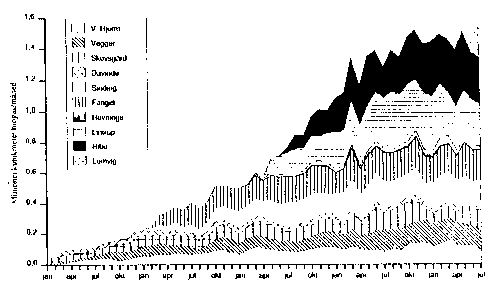



| Biomass |




| Biomass |
Biogass
Ole Skadborg, Viborgegnen's Energy and Environment Office Ann Vikkelso, Copenhagen Environment and Energy Office
Biogas technology was introduced in the last century; first of all as a sanitary measure, as well as for reduction of volume and smell of the increasing amount of garbage from the growing cities. A real utilization of biogas was only introduced in this century.
Today biogas plants gain prevalence all over the world as a method for energy production and recycling of nutrients for cultivation of plants. The sources are farmyard manure, plants, remains of plants, and organic waste from industry and households.
Today, there are two types of plants in Denmark; farm plants and joint plants. The farm plants have the advantage that long-distance transport of liquid manure is avoided. On the other hand it may be a problem, that more energy is produced than used a« the farm. An advantage of the joint plants is, they can be located close to an urban area and supply district heating.
Biological process and products
In the biogas process high-molecular organic material is cracked to low-molecular, inorganic substances and gas by means of anaerobic (oxygen free) bacteria:
Biomass + Bacteria -> Gasses + Nutrients
CHO (N,P,K,S..) -> CH4, CO2,N..+ N,P,K,S..
The decomposition more or less corresponds to the processes which take place in the nature, but with the difference that the natural processes mainly take place by presence of oxygen (are aerobic). Therefore the intermediate products of the processes are different, as well as the chemical composition of the end products.
In traditional Danish agriculture the alternative of using farmyard manure for biogas production is to put it on the fields where it decomposes in an aerobic process. This process goes off slowly, and nutrients (e.g. nitrogen) risk being washed out before the plants manage to absorb them. Likewise, the energy potential of the biomass is not being utilized.
In a biogas plant the biomass is converted into methane, for instance, which is collected and utilized for energy production. In this way, imported fossil fuels are replaced, Danish currency is saved, and air pollution decreases. The degassed biomass (bio sludge, or liquid and solid manure) with a great part of the nutrients on mineral form can easily be utilized in traditional agriculture, as it is very similar to artificial fertilizer. At the same time, the degassed manure is provided with some positive elements compared to untreated farmyard manure, figure 11.9. As less nutrients are lost than by traditional treatment of manure, the consumption of artificial fertilizer is decreased.
Some organic and biodynamic farmers are very sceptical towards biogas. The problem is that a larger part of the nutrients are mineralized after the biogas process. Because bio sludge is so similar to artificial fertilizer with the nutrients on an easy accessible form, the plants are forced to absorb more nutrients and absorb them faster than, when nutrients are slowly liberated due to natural (aerobic) decomposition of organic matter at the field. This generates plants that are less healthy and more sensible to diseases, etc. The problem with nutrients being washed out is in general much smaller at organic farms, as they are more careful when manuring than in traditional agriculture where farmyard manure is often seen as a waste product.
Anyway, this is a longer discussion, and we will not go into details here. But there is no doubt that other biogas systems must be developed, if biogas production shall be suitable for organic farming.
The Biogas Process
In a biogas plant the biomass is heated up to the process temperature in an air tight reactor and a sufficient process period is secured. The usual process temperatures are either in the area (30-40›C) or thermophile area (50-60›C) and with 10-20 days stay in the reactor. The process is quicker at high temperature, that is why the staying period and the reactor volume can be decreased. On the other hand, the demands for process control and heat recovery are larger with high process temperature.
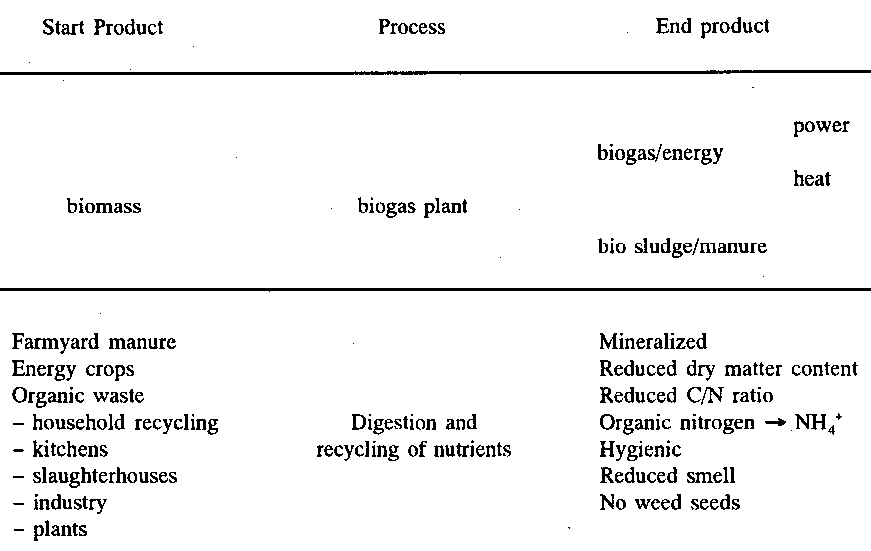
Today the thermophile process is considered to be easy to control, and projects that are big enough to include investment in heat recovery are mostly based on the thermophile process, the highest hygienic standard is also achieved like that. Especially when handling human waste, as kitchen waste and waste water, that later will be used as fertilizer, a high hygienic standard is demanded by the veterinary authorities. This can be achieved by securing that the material is 55 ›C for at least 4 hours or 70›C for 1 hour.
The biogas formed in the process is a mixed gas consisting of 60-70% CH4 (methane), 30-40% CO2 (carbon dioxide), 0-1% H2S (hydrogen sulphide), as well as traces of H2 (hydrogen) and N2 (nitrogen). The inflammable part is methane that has a heating value of 10 kWh per mì CH4. This means that biogas has a heating value of 6-7 kWh per mì biogas.
Design of Biogas Plants
A biogas plant consists of:
* Pre-storage tanks (receiving unit) where farmyard manure and other biomass products are mixed before being pumped to the process tank (digester)
* Reactors where the process takes place and the heated biomass is degassed
* any special sanitation tanks
* Manure tanks, where the degassed liquid manure can be stored until manuring the fields
* Any gas storage
* Gas furnace or cogeneration plant
Figure 11.10 shows the design of a biogas plant, in this case a joint biogas plant with separate receiving unit. It receives solid and liquid farmyard manure from several farms and various other biomass products that are mixed and pumped to a pre-storage tank. At smaller (farm) biogas plants the receiving unit is normally reduced to a prestorage tank, for the rest the principle design is the same.

The biogas is utilized in gas boilers or cogeneration plants. Figure 11.11 shows the principle of a gas-fired cogeneration plant.
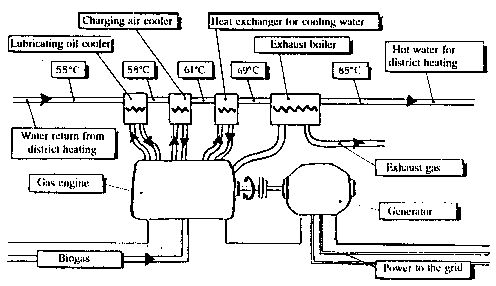
Biogas Potential
The biogas production in agriculture is based on farmyard manure which is nowadays often supplemented with other biomass to optimize the biogas production and profit. The supplement increases the content of nutrients and in some cases generates profit from receiving organic waste products. This waste would cost the producers more to get rid of in another way, e.g. at deposits.
The biogas potential in farmyard manure with a dry matter content (TS) of 5 % are of the order of
0.2-0.3 m CH4/kg VS (volatile organic dry matter) or 100-150 kWh per tonnes liquid manure. The potential depends on how the animals are fed and how they digest the food, in addition to the dry matter content. Therefore the variation is very big. In general the following normative figures for biogas potential in manure from different animals can be used:
|
1 cow (500 kg) |
7 kWh/day |
|
1 sow (150 kg) |
2 kWh/day |
|
10 porkers (60 kg each) |
9 kWh/day |
|
200 poultry |
10 kWh/day |
Many other kinds of biomass both have a higher content of organic dry matter than farmyard manure, which for liquid manure is 3-6%, and higher energy potential of the dry matter, figure 11.12.
Farm Biogas Plants
The first agricultural biogas plants that were built in Denmark, were individual farm plants with vertical or horizontal reactors. There was no development for some years, but the development of cheap standardized farm biogas plants has started again, and during the last years several new plants have been built, figure 11.13.
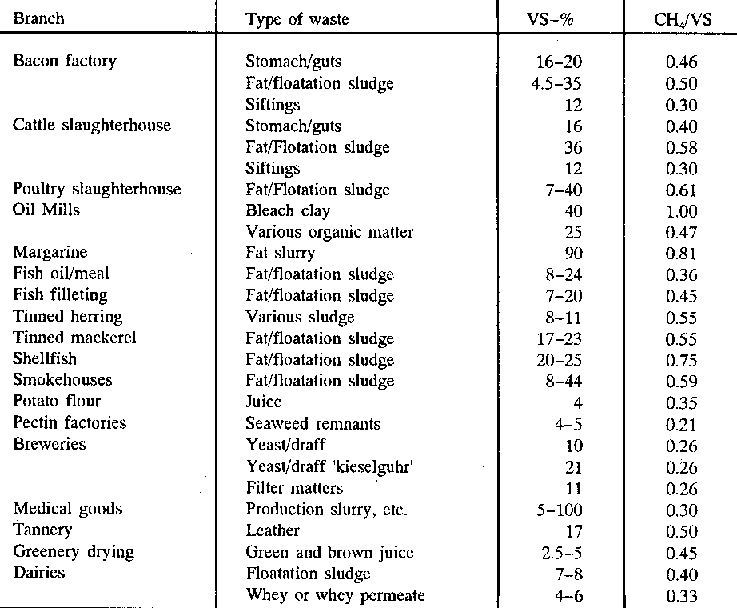
Today work is going on to make manure tanks into low-temperature biogas plants by equipping the tanks with heating and establish a membrane covering (soft-top) under which gasses are collected, figure 11.15.
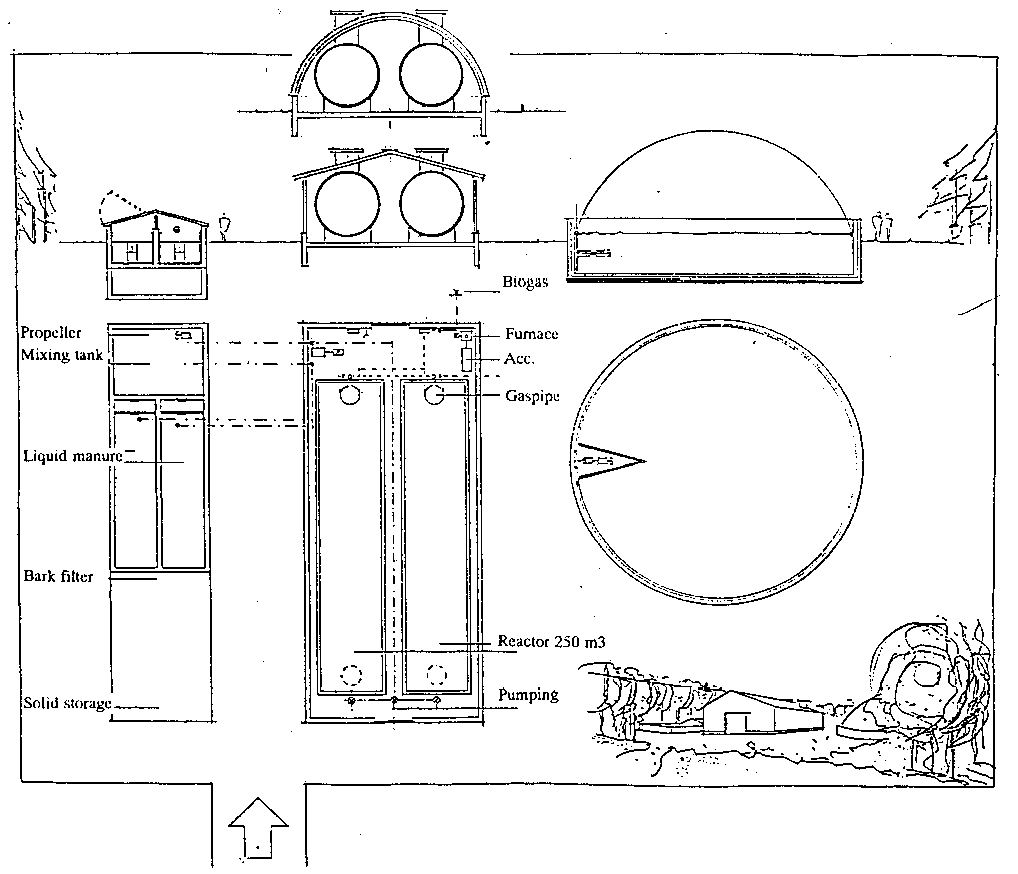
Joint biogas plant
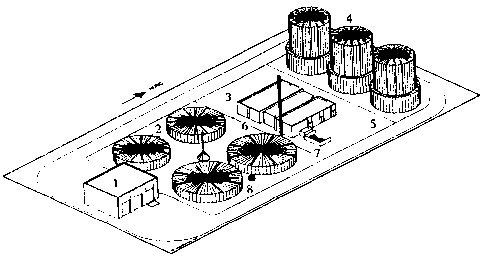
1. Reception building.
2. Prestorage tanks, 1069 m each.
3/6. Heat exchanger.
4. Digesters (reactors), 3 pcs, 2600 m each.
5. After-sanitation channel.
7. Chips. Delivery and burning.
Heats manure to 55›C.
8. Storage tanks, 1560 m each.
During the last years special efforts have been made to build and test centralized joint biogas plants where the farmyard manure from several farms is transported by slurry tankers to centralized treatment together with other kinds of organic materials. The degassed manure is brought back to the manure tanks at the farms or to new-built storage tanks at places where the manure will be utilized, again by a slurry tanker.
In Denmark, there have been built 10 joint biogas plants of different sizes where continuous registration of operation and production results are made. Registration is also made on 9 of the farm plants.
As and alternative to the existing plants, Viborgegnen's Energy and Environment Office works on predesigning plants where transport of manure by slurry tankers is replaced by pumping.
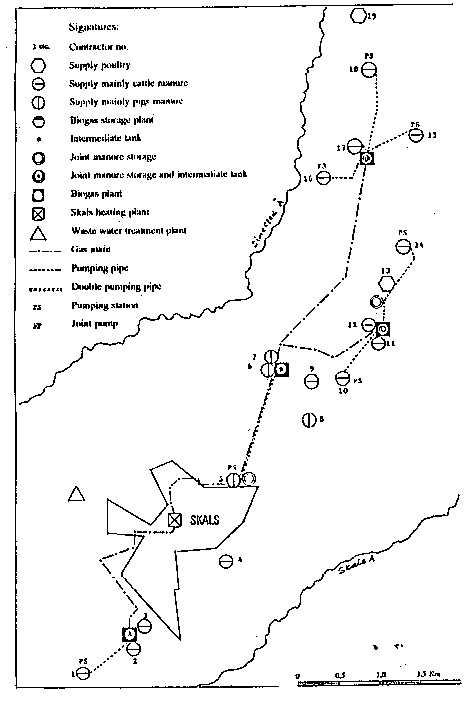
Future Perspectives
Establishment of biogas projects includes more questions than this article could cover. But through the experiences yielded in Denmark good expertise in the biogas field is established. And the earlier scepticism towards biogas plants has turned into a growing interest, not least because of the enhanced and documented operation and production results (figure 11.18).
